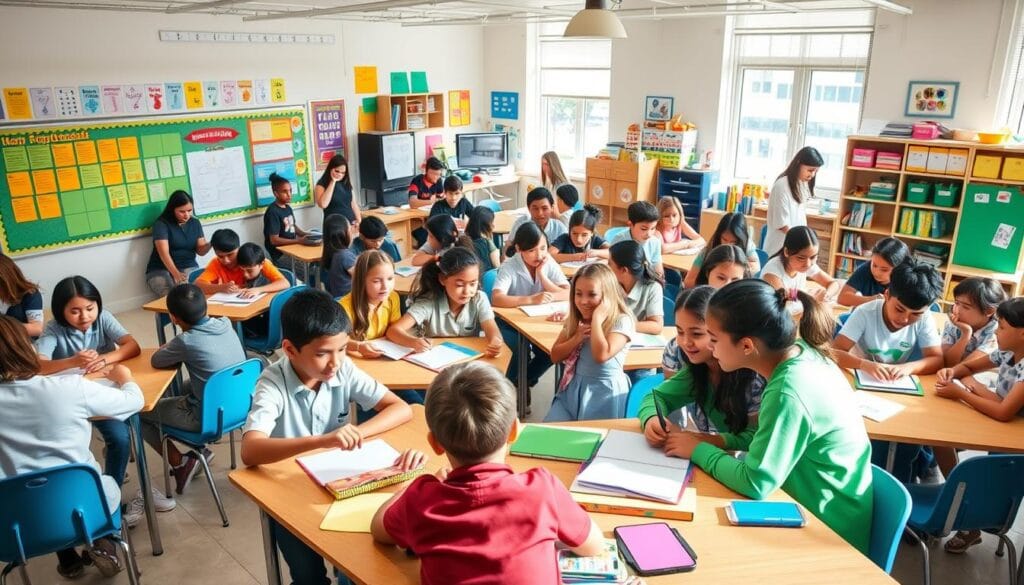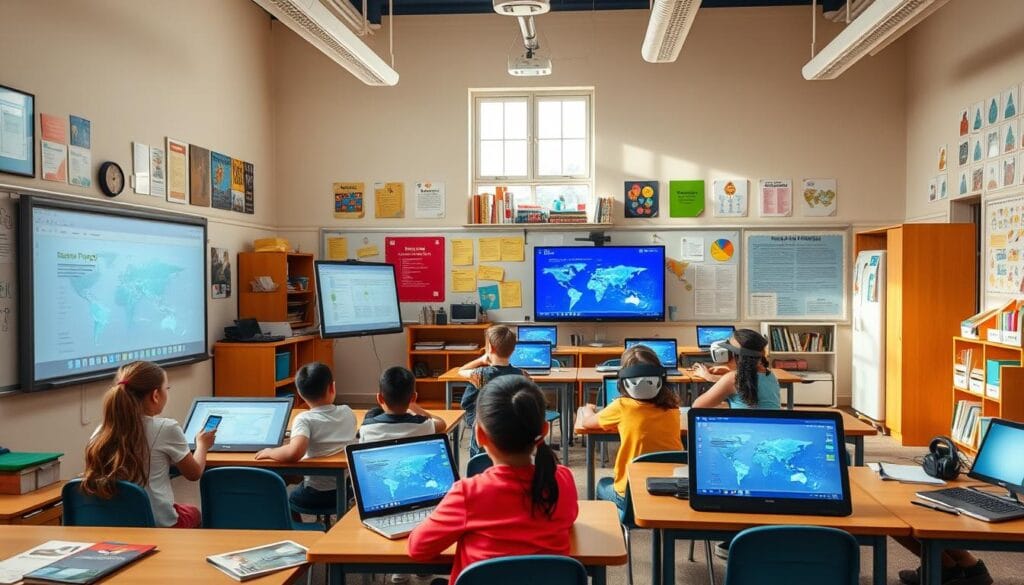The Most Valuable Lesson from My First year of teaching
Starting as a teacher can be a life-changing experience. It shapes your career path. The first year is full of challenges, but the lessons learned are priceless. One key lesson I learned was the need to accept the reality of teaching and be resilient.
فهرس المقالة
Understanding the Reality of First Year Teaching Lessons
Starting as a new teacher comes with its own set of challenges. You’ll need to learn classroom management and time management. This transition can be both rewarding and overwhelming.
Common Challenges New Teachers Face
One big challenge is setting up effective classroom management. It’s hard to keep discipline, create engaging lessons, and meet all students’ needs. Time management is also tough, balancing teaching, admin work, and personal life.
Setting Realistic Expectations
It’s key to have realistic goals for your first year. You won’t know everything right away, and that’s fine. Focus on learning and improving, not on being perfect. Celebrate small wins to build a strong teaching career.
Building Professional Resilience
Being resilient is crucial for your first year. Seek help from colleagues, mentors, and professional events. Learn from mistakes, take feedback, and adjust your plans as needed. This way, you can overcome hurdles and succeed in the classroom.
The first year of teaching is a learning journey. By understanding the challenges, setting realistic goals, and building resilience, you can start a successful teaching career.
Essential Classroom Management Strategies That Work
As a new teacher, it’s key to master classroom management. This helps create a great learning space and keeps students engaged. Here are some top strategies that work well:
- Set Clear Expectations: Start by setting clear rules and procedures. Tell your students what’s expected and remind them often. This keeps your classroom orderly and disciplined.
- Use Positive Reinforcement: Reward good behavior to motivate students. Give praise, prizes, or chances to lead. This builds respect and responsibility in your classroom.
- Try Active Learning: Make lessons interactive and hands-on. This keeps students focused and involved. It also cuts down on bad behavior.
| Classroom Management Strategy | Benefit |
|---|---|
| Developing Classroom Routines | Promotes structure, stability, and predictability, which can reduce student anxiety and improve focus. |
| Implementing Effective Transitions | Minimizes downtime and maintains momentum, preventing opportunities for disruptive behavior. |
| Fostering Student Accountability | Encourages students to take ownership of their learning and behavior, promoting self-discipline and responsibility. |
By using these classroom management strategies and student engagement techniques, you can make a positive learning space. This space helps your students do well in school and socially.
Building Strong Student Relationships for Better Learning
As an educator, building strong relationships with your students is key for their success. By creating a supportive learning space and gaining their trust, you can help them reach their full potential. This section will cover how to connect with students and handle different personalities.
Creating a Supportive Learning Environment
A welcoming classroom is the base of a strong teacher-student bond. Use student engagement techniques like listening actively and giving positive feedback. Also, celebrate their wins and be open to their questions and concerns.
Fostering Student Trust and Respect
Trust and respect are vital in any good relationship, including the classroom. Show your students you’re reliable and fair. Also, respect their views and differentiated instruction needs, letting them share their stories.
Managing Different Personality Types
Every student is unique, with their own learning ways and interests. Tailor your teaching to meet these diverse needs. Watch your students closely and adjust your teaching to help them learn best.
By focusing on strong relationships and a supportive classroom, you can build a deeper bond with your students. This can inspire them to grow both academically and personally.

“The most valuable thing you can make is a meaningful connection.” – Susan Cain
Time Management: Balancing Teaching and Administrative Duties
Starting as a new teacher can be tough. You have to juggle teaching and admin tasks. But, with good time management, you can do both well and have a great year.
First, make a to-do list. Sort tasks by how urgent and important they are. This helps you tackle the most critical ones first.
- Make a schedule: Set times for planning, grading, and admin work. Try to stick to it to keep things organized.
- Use technology: Find digital tools to make your work easier. Apps can help with things like tracking attendance or grades.
- Share tasks: Give some work to students or colleagues. Working together can make things easier and help you learn from others.
- Take breaks: Don’t forget to rest and do things you enjoy. Exercise, meditation, and spending time with family can keep you energized.
By using these strategies, you can manage your time better. This lets you focus on teaching and making lessons fun for your students.
| Time Management Strategies | Benefits |
|---|---|
| Prioritize tasks based on urgency and importance | Ensures critical tasks are addressed first |
| Establish a structured schedule | Maintains a sense of order and reduces overwhelm |
| Leverage technology for administrative tasks | Streamlines workflow and frees up time for lesson planning |
| Delegate and collaborate with colleagues | Shares the workload and promotes learning from best practices |
| Practice self-care | Prevents burnout and maintains a healthy work-life balance |
“Effective time management is not just about doing more, but about doing the right things at the right time.”
Effective Lesson Planning for Student Success
As an educator, making engaging lesson plans is key to keeping students interested and achieving well. By using different learning styles and adjusting plans based on feedback, you can make your classroom a place where everyone can succeed. Also, using educational technology can make learning more fun and tailored to each student.
Incorporating Diverse Learning Styles
Good lesson planning means knowing what your students need. Use a mix of methods like pictures, hands-on activities, and group work. This way, all students can learn in a way that feels right to them.
Adapting Plans Based on Student Feedback
Always ask for feedback from your students to see if they get the material. Listen to what they say and change your plans as needed. This way, you can fix any problems and keep your lessons up to date and effective.
Integration of Technology in Lessons
Using educational technology tools can make your lessons better. Look into digital tools like interactive boards, apps, and online platforms. By adding these lesson planning tips to your teaching, you can make learning more fun and valuable for your students.
Good lesson planning is the key to helping students succeed. By meeting different learning needs, listening to feedback, and using technology, you can create lessons that motivate and inspire your students to do their best.
Navigating Parent-Teacher Communications

Good communication between parents and teachers is key for student success. As a teacher, it might seem tough to handle these talks. But, with the right methods, you can build strong relationships and help your students grow.
Parent-teacher conferences are a big part of this. They let you talk about a student’s progress and find ways to help them learn more. To make these meetings work, prepare well, listen carefully, and look for solutions.
It’s also vital to keep talking to parents all the time. You could send updates on what’s happening in class and how students are doing. Ask parents to share their thoughts and answer their questions quickly. Remember, parents are your allies in helping students learn.
When parents have concerns, listen with understanding and look for ways to solve the problem. Listen well, respect their views, and find solutions together. This way, you can build trust and a strong partnership.
In the end, good communication with parents is crucial for managing the classroom well. By working together, you can create a supportive environment that helps students succeed in school and life.
“The most important thing that parents can do is to be involved in their child’s education from an early age and to remain involved throughout their child’s school years.”
Assessment Strategies That Drive Student Growth

As an educator, knowing the power of assessment is key to student success. Classroom assessments help track student progress and guide teaching. By understanding formative and summative assessments, you can improve your teaching and help students succeed.
Formative vs. Summative Assessment Methods
Formative assessments are the heart of student-centered learning. They give feedback in real time, helping you adjust your teaching. Examples include classroom talks, exit tickets, and quick quizzes.
Summative assessments, however, measure learning at the end of a unit or course. They give a full picture of student achievement. Examples include standardized tests, final exams, and projects.
Using Data to Inform Instruction
Data from assessments is crucial for teaching each student differently. It shows what students know and what they need to work on. This helps you tailor lessons and support students to reach their best.
Providing Constructive Feedback
Good assessment strategies also mean giving feedback that helps students grow. Instead of just scores, focus on comments that guide improvement. This feedback can be written, one-on-one, or through peer discussions, helping students learn and grow.
| Formative Assessment | Summative Assessment |
|---|---|
| Ongoing, informal evaluation of student learning | Final, comprehensive evaluation of student learning |
| Provides real-time feedback to guide instruction | Measures achievement at the end of a unit or course |
| Examples: Classroom discussions, exit tickets, quizzes | Examples: Standardized tests, final exams, projects |
By using a variety of classroom assessment methods and differentiating instruction, you create a learning environment where all students can succeed.
Self-Care and Professional Development Tips
Starting as a new teacher can be both thrilling and tiring. It’s not just about planning lessons and managing the classroom. Taking care of yourself and growing professionally is key. By focusing on self-care and learning, you’ll become more resilient in your teaching career.
Learning to prioritize your well-being is a vital lesson in your first year. It’s easy to get caught up in the job’s demands. But, making time for self-care helps prevent burnout and keeps your work and personal life balanced. Here are some tips to add to your daily routine:
- Practice mindfulness or meditation to manage stress and cultivate inner peace.
- Engage in regular exercise, even if it’s just a short walk during your lunch break.
- Prioritize quality sleep, as fatigue can significantly impact your energy and productivity.
- Establish firm boundaries between work and personal life, and don’t hesitate to unplug when needed.
Investing in your professional growth is also crucial. Look for workshops, conferences, or online courses that match your teaching interests. Join a professional learning community online or locally. This way, you can connect with other teachers and share ideas.
Remember, your well-being and professional growth are not extras. They are essential for being a great and happy teacher. By focusing on self-care and learning, you’ll be ready to face the challenges of your first year and beyond.
“The best teachers are those who show you where to look, but don’t tell you what to see.” – Alexandra K. Trenfor
Leveraging Educational Technology in the Classroom
Being an educator today means using educational technology. These educational technology tools can change your classroom. They engage students and improve their learning.
Interactive whiteboards are a great example. They let you add multimedia, interactive exercises, and real-time collaboration to your lessons. This makes learning more fun and interactive for students.
| Educational Technology Tool | Key Benefits |
|---|---|
| Virtual Learning Platforms | Provide access to a wealth of digital resources, facilitate remote learning, and enable seamless communication between students and teachers. |
| Gamification Tools | Inject an element of fun and competition into your lessons, motivating students to actively participate and learn. |
| Classroom Polling Apps | Gather real-time feedback from students, assess their understanding, and adjust your teaching approach accordingly. |
Using these educational technology tools wisely can make your classroom more engaging. Choose tools that fit your teaching goals and improve learning for your students.
“Technology is just a tool. In terms of getting the kids working together and motivating them, the teacher is the most important.”
– Bill Gates
As you try out educational technology, always think about your students first. With the right student engagement techniques, you can make the most of these tools. This will help your students succeed.

Cultivating a Growth Mindset in Students and Yourself
As an educator, teaching your students about a growth mindset is crucial. This mindset, developed by Carol Dweck, believes that intelligence and abilities can grow with effort. It helps students see challenges as chances to learn and grow.
Teaching a growth mindset starts with differentiated instruction. This method tailors learning to each student’s needs. It makes sure everyone feels they can succeed, no matter where they start.
Using classroom assessment methods that focus on progress also helps. Instead of just looking at test scores, focus on how much students have learned. This shows them that learning is a journey, not a fixed goal.
“Believe you can, and you’re halfway there.” – Theodore Roosevelt
It’s key for teachers to show a growth mindset too. Share your own learning experiences and celebrate your achievements. This shows students that learning is a lifelong journey.
Teaching a growth mindset changes both teachers and students. It helps students face challenges, learn from mistakes, and reach their full potential. By adopting this mindset, you’ll see your students grow into confident learners.
Conclusion
As your first year of teaching ends, take time to think about what you’ve learned. You’ve faced classroom management challenges and built strong bonds with your students. You’ve shown you can adapt and overcome tough times.
The journey of teaching never stops. See every challenge as a chance to grow and learn more. Keep working on yourself, looking for ways to get better, and always aim to make learning exciting for your students.
Your love for teaching has carried you this far, and it will keep you going. Celebrate your wins and learn from your mistakes. Always put your students first. With a growth mindset and a drive to improve, you’ll keep making a big difference in their lives.
FAQ
What are some of the most valuable lessons I can learn from my first year as a teacher?
Your first year of teaching can change your career. You’ll learn to handle classroom challenges, set goals, and grow as a teacher. These lessons help you improve your teaching every day.
What are some of the common challenges new teachers face?
New teachers often face classroom management and time issues. They also struggle with teaching and administrative tasks. Setting realistic goals and building resilience helps overcome these challenges.
What are some effective classroom management strategies for new teachers?
Effective strategies include discipline, a positive environment, and student engagement. Use clear rules, positive reinforcement, and active learning to manage your classroom.
How can I build strong relationships with my students for better learning?
Building strong student-teacher relationships is key. Trust, respect, and different teaching methods help create a supportive environment. This way, you can meet the needs of all your students.
How can I effectively manage my time as a new teacher?
Time management is vital for new teachers. Prioritize tasks, create schedules, and avoid burnout. Balancing teaching and admin tasks helps you focus on your students.
What are the key elements of effective lesson planning?
Good lesson planning includes diverse learning styles and technology. Adapt plans based on feedback and use educational tools. This makes your lessons engaging and relevant to your students.
How can I communicate effectively with parents as a new teacher?
Effective communication with parents is crucial. Conduct successful conferences, address concerns, and build positive relationships. This supports your students’ success.
What assessment strategies can I use to drive student growth?
Use formative and summative assessments, analyze data, and give feedback. This helps you understand student learning and tailor your teaching.
How can I prioritize self-care and professional development as a new teacher?
Self-care and development are essential. Maintain balance, manage stress, and seek learning opportunities. This prevents burnout and helps you grow as an educator.
How can I effectively leverage educational technology in my classroom?
Using educational technology can improve learning. Explore different tools and strategies to support your teaching and engage your students.
How can I cultivate a growth mindset in my students and myself?
Fostering a growth mindset is vital. Embrace challenges, persevere, and seek learning opportunities. This mindset benefits both teachers and students.






